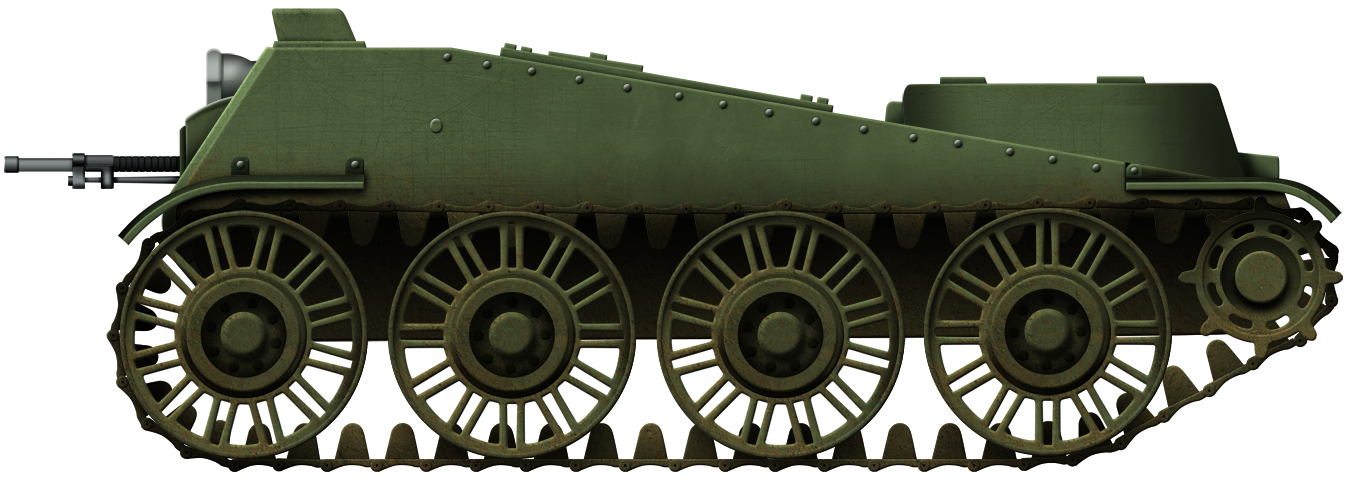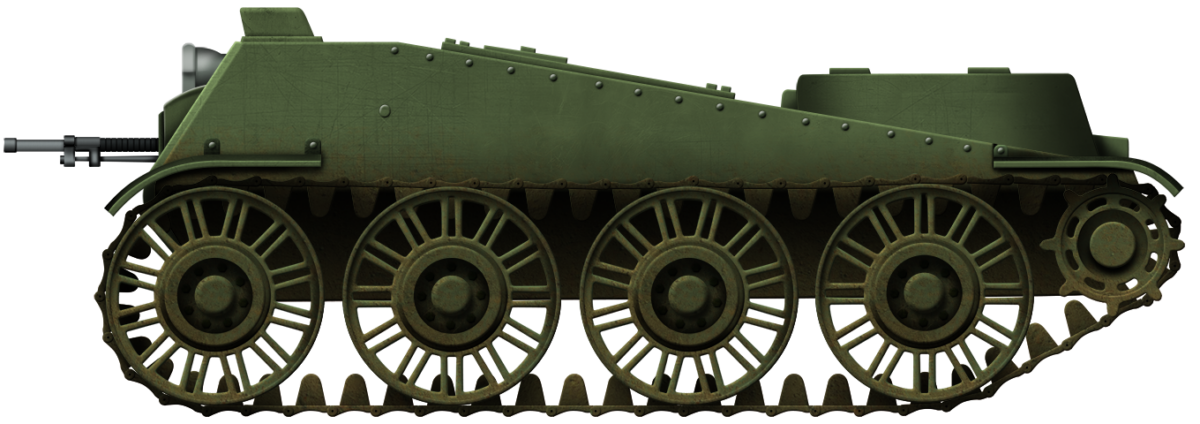 Soviet Union (1940)
Soviet Union (1940)
Mobile Machine Gun Nest – 1 Prototype Built
The Soviet-Finnish War of 1939-1940, more commonly known in the West as the ‘Winter War’, saw many one-off vehicles being designed to help the Soviet Red Army overcome the determined Finnish defenses. Many of these never made it to the front to be tested under fire.
One example of such a unique design was the Object 217, also known as the Podvizhnoye Pulemyotnoye Gnezdo or mobile machine-gun nest.
Background
As the Soviet Red Army set about reorganizing itself in January 1940 due to its ineffectiveness in the opening month of the conflict, many meetings were held to discuss how best to tackle the various obstacles encountered in Finland.
One complaint was the lack of tank/infantry coordination. More often than not, the Soviet tanks would charge ahead and smash through the Finnish lines. The Finns used this to their advantage by allowing the tanks to pass and then reoccupying their positions soon after and shooting at the following infantry. To help counter this, several designs for infantry shields and tank-drawn armored sleds were produced by the various factories of Leningrad (modern-day St. Petersburg). These allowed for sections of infantry to be towed in relative safety to the Finnish lines in order to secure them before the Finns returned.

However, this was not always successful. Once the Finns understood the method of delivery, they used their valuable anti-tank guns to target the towing tanks, or they adapted their defensive positions in order to provide incoming fire as quickly as possible.
Another solution
Another idea was to design a machine-gun-armed tankette that could support advancing infantry. The already existing T-27 was too tall, too weakly armored, and performed too poorly in the snow. As the fighting was in full swing, a quick, cheap design was needed. The task of designing such a vehicle was given to Special Design Bureau No. 2 of the Leningrad Plant of Experimental Engineering No. 185, also known as the Kirov Plant, under the leadership of Josef Yakovlevich Kotin. Kotin created a team under Leading Engineer L. E. Sychev and given the project designation of ‘Object 217’. It was soon called Podvizhnoye pulemyotnoye gnezdo or mobile machine-gun nest by the team.

The design team quickly produced technical drawings based around a four-speed motorcycle engine with simple suspension. By the beginning of March, a prototype was ready and sent for factory testing. Another four prototypes were also being constructed for trials. The assessors were initially impressed with the vehicle as it fulfilled all the requirements laid out in the request. Even so, the design had numerous drawbacks that called into question its usefulness.
The two Degtyaryov DT machine guns had limited arcs of fire, the crew positions caused discomfort and fatigue within short periods of time, and the armor was seen as too weak when coupled with the limited mobility. However, none of these deficiencies was the reason for not adopting the machine. On 13th March 1940, the Winter War came to a close and there was no longer a need for such a niche vehicle. As a result, the Armored Directorate of the Red Army canceled the project. All the prototypes were scrapped.
Specifications
Hull
The Object 217 used a single-piece of rolled armored steel to form the main body of the vehicle. To this were welded and riveted the side and rear armor. The designers wanted to minimize the silhouette. To do this, they created an oddly laid out fighting compartment. The two crew members sat with the two access hatches on top of the vehicle open during transportation, but when in combat they would adopt a prone position, lying face down inside. At its maximum height, the Object 217 measured only 55 cm. To allow the crew to see, they were each provided with simple periscope devices that protruded from the roof and covered in an armored box. However, this meant that the two crew members had no visibility to their sides and rear.
The commander was seated on the right side, with the driver on the left side of the vehicle.
A headlight was present on the right-hand side, while a smaller rear light was also present on the left-hand side.

Engine and Transmission
To keep the costs down, a PMZ motorcycle 16 horsepower two-stroke, 2-cylinder, air-cooled petrol engine was used for this vehicle. This allowed for limited self-propulsion which was not an issue, as the deployment of the vehicle involved being towed behind a T-26 until it reached the Finnish defenses and then unhooking itself. The transmission was a three-speed gearbox seated next to the engine. A simple friction clutch system controlled by a set of levers was used to control the movement of the vehicle. The factory tests gave a top road speed of 18.5 km/h and a cross country speed of 7 km/h. Due to the large size of the engine in comparison to the internal space available, it was necessary to create an armored box at the rear of the vehicle with several access panels.
The trials also showed that the Object 217 was capable of climbing 30-35 degree inclines and could clear trenches 1 meter wide. It could also wade through streams and puddles so long as they did not exceed half a meter in depth. How this would have translated to the Karelian Isthmus though is not known. The relatively low ground pressure was ideal for getting across the snow but the varied terrain, especially at the specially selected areas of the Mannerheim Line, would probably be taxing on the vehicle.

Running gear
The Object 217 was given a very simple running gear. This consisted of four large cast spoked road wheels which were fixed to rigid axles. To provide power, a drive wheel, about half the size of the road wheels, was installed at the rear. The front road wheels could also turn like the wheels on a car, bending the track in order to allow the vehicle to steer, in a similar style to the later Light Tank Mk VII Tetrarch. To lower the amount of dust and snow thrown up by the tracks, the front and rear had protruding fenders.
The lack of suspension was one of the biggest drawbacks to the design. It put a considerable strain upon the crew, especially under combat conditions that required them to lie down. After only a short while, the assessors reported fatigue which would only make the combat effectiveness of the vehicle worse.
Armor Protection
For the type of vehicle and time, the Object 217 boasted an acceptable armor layout. The front consisted of a rolled single piece of armored plate measuring 20 mm in thickness. The sides were 10 mm thick rolled single pieces that were mainly welded upon the body, with a few rivets in the rear of the vehicle to help strengthen it. The roof and underside were 8 mm thick rolled armored plates. The advanced use of single rolled pieces of armored plate coupled with a heavy reliance on welding gave it a great amount of protection against small arms and shell fragments.
The assessors did express concern about the armor’s ability to withstand anti-tank gunfire or near hits by artillery but this was less about the armor and more about how the limited mobility meant an overreliance upon the armor for protection.

Armament
The original directive stipulated that the vehicle had to be armed with a machine gun. This was due to its main task being to keep the Finnish defenders suppressed. The design team added two Degtyaryov DT machine guns in ball mounts which would be aimed using the attached sights. These allowed for 20 degrees of travel in all directions, but this was limited more due to ergonomics within the hull rather than the installations themselves. The sides of the hull contained racks for 25 pan-type magazines, giving a total ammunition amount of 1,575 rounds per gun. In order to allow the crew to maintain operation without the need to clear spent shell casings, each gun mount had a specially designed bag that connected to the side ejection port.
Analysis of possible use
It is not sure how Object 217 would be deployed but some speculations can be made based upon the tactics used by the Soviets during the second offensive phase of the Winter War.
Possibly, after a heavy artillery bombardment upon a section of the Finnish line, a squadron of 12 T-26s would set off, 2 towing Object 217s and 4 towing Sokolov sleds (each carrying 5 Soviet soldiers). As the tanks neared the line, they detached the tow cables and the soldiers advanced to the trenches. The Object 217s would take positions on the flanks, suppressing the Finnish defenders. With these types of tactics, which were deployed during the second offensive phase, but with T-26s taking the role that the Object 217s would have played, it would allow for more tanks to be pushed into the breakthrough and still have the Infantry secure the position. The vehicles could then use their own power to cross the trenches and be ready for any Finnish counterattack.
Conclusion
The Object 217 was a unique vehicle designed for a unique situation. As the Soviet advance stalled by the indefatigable Finnish defense in December 1939, the Soviet Red Army needed any solution to breakthrough. The solution of an armored machine gun position attached to the infantry was a quick fix as it negated a lengthy rework of the current Soviet tactics. The final vehicle produced, however, was inherently flawed as a design. With such extremely limited visibility and a very uncomfortable fighting position for the crew its combat potential was small. The crew would become rapidly tired and the mobile and adaptable Finns would no doubt have quickly learned of its serious limitation and come up with tactics to exploit its weaknesses using their mobility to get around it. With the end of the Winter War the serious deficiencies of the design were never shown by actual combat but the fact that this design was not repeated again is perhaps the strongest indication that this unique vehicle was not an effective solution to breaching well prepared enemy defences. To do that would rely on a far better use of coordinated operations and flexible vehicles supported by artillery – something the Soviets repeatedly failed to manage during the Winter War.

Sources
Komolyets, Maxim. Tanks in the Winter War: 1939 – 1940 (Operations: Scandinavia 1939) (Leandoer and Ekholm (April 14, 2009))
https://warspot.ru/2973-proekt-217-mobilnaya-ambrazura
https://topwar.ru/105675-podvizhnoe-pulemetnoe-gnezdo-tanketka-obekt-217.html


2 replies on “Object 217, PPG”
Howdy.
I found the following for y’all on Yandex while searching for a better photo of Object 217 to save in my archive. It appears to be the original photo of Object 217 that is cropped in your article. There is a second photo on the same page displaying Object 217 with its hatches up.
Cheers!
https://d.radikal.ru/d23/1912/93/96f25319c43e.jpg
Thank you, added to the site!